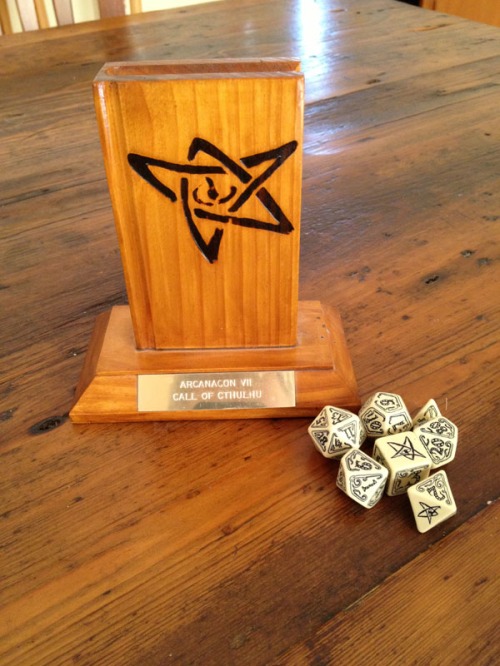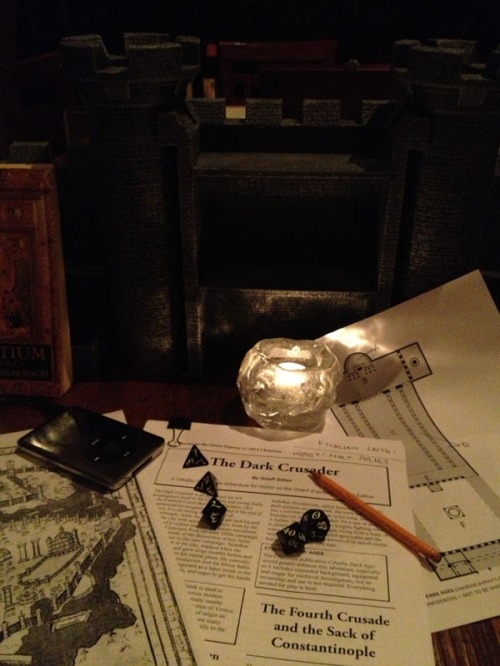Last night we played “The Dark Crusader” by Geoff Gillan, the brand new Cthulhu Dark Ages scenario for Horror on the Orient Express. It was an interesting group, as only one of our regular 1920s group play testers could make it. Of the others, one knew of the 1991 campaign from years ago, one had read it recently, one knew nothing at all, and one was Penny… who we can say knows more than a bit (although nothing about “The Dark Crusader”).
It worked really well; Geoff has outdone himself. The clues and drama moved the players seamlessly from one location to the next, the backdrop of the Fourth Crusade was rife with tragedy and horror, and there were some scenes that were creeping me out, and I was the one running it. The players praised it at the end, particularly the regular play tester, who thought it blended really well with the larger story. I timed the play test so that it ran the Saturday after the 1920s group found the illuminated 13th century manuscript in the Wednesday game.
The historical scenarios are not dreams nor past lives nor out of body experiences; they are in effect playable player handouts, with pre-generated characters. In this case the characters were mostly created by Geoff’s original play testers (including Cthulhu Reborn meister Dean), and the personalities were great. I was not so convinced by their skill chances, so I’ll be increasing some of those so that each player can shine when his or her character’s specialty is called upon.
I have not run Cthulhu Dark Ages before, and to be frank (actually, the players were Franks – oh stop, I’m killing me – Frankish knights, geddit? – I’ll be here all week, try the chicken) I found that combat ran a little slow. Armour is good at soaking medieval amounts of damage (who knew?) so even the simplest battle encounter slowed the game down for me. In the edits, I’ll add suggestions for Keepers as to what the key is for winning each fight, so that players do not need to kill everything in all scenes. I’ve co-opted this from the “out” suggested for Dungeons & Dragons 4th edition fights, from work by Michael Shea and others. (And yes, that is indeed a D&D screen in the photo above; it seemed like the right choice for an adventure set during a medieval siege. It’s the most ridiculous RPG accessory I own, but in my defence I got it on special from a store which was closing down where I had $100 credit to burn. Don’t judge me.)
Backing up to the point above: our Orient Express play test games are not proper RPG sessions. We simply don’t have time, as we need to knock over a city a night. Hence my impatience with combat length. This ticking clock applies to all scenes. I’ve asked the players to focus their roleplaying on the plot at hand, and not to introduce sub-plots and dynamics from their own characters. I also don’t have time for the usual to and fro around the table where the players decide what to do; you know how it goes, an issue comes up with a few different approaches, no-one agrees, the discussion starts going around and around with plenty of repetition but no resolution in what Danny Bilson once called “a cycle of failure”. And there’s me, watching the clock, thinking If they just decided on something we could all see what happens, instead of sitting here deciding what won’t.
Hence the decision totem.
This is a pretty cool artifact; in 1989 I wrote a tournament module called Persons Unknown set in 1980s Scotland about a group of amnesiacs in an asylum. Marion Anderson had a tremendously cool idea for our trophies: she made an Elder Sign brand, and burned the image into our wooden book trophies. There was a spare left over, and Marion was kind enough to give it to me. It’s been a keepsake all these years, and now it’s a prop.
It sits on the table in front of one player. So, when the players are in a cycle of failure, I quickly summarise the options they have proposed, look at the person with the decision totem and say “Choose”. He chooses, then moves the totem widdershins around the table to the next player, and the game moves on.

Call of Cthulhu trophy with Elder Sign brand, made by Marion Anderson for Arcanacon VII (Melbourne, 1989)
Our play testers are tainted, in any event. Not morally, but they know they are play testing Horror on the Orient Express, so they are the most diligent, focused, fantastic set of players you could ask for; they take their job seriously, so they are very attentive to all clues. I wish you the same luck with whoever you run the campaign for (Rule One: No smartphones in the 1920s), but suggest you contract with them before you start. If everyone pays attention, stays in character and takes the game seriously, it is better by a margin of strange aeons.
It’s a heady brew: the combination of such great players, such detailed material, the worldwide support of gamer investors and the thrill of an engaging and deep creative project. This is turning out to be one of the best campaigns I’ve ever run. I hope it is the same for you.
Oh, and a postscript: While my players in Melbourne Australia were in Constantinople 1204, at that exact hour on the other side of the planet, Oscar Rios’s players in New York were in Vinkovci 1923. Two Keepers, two groups, two cities, two Cthulhu eras, but the same campaign. That felt good.






